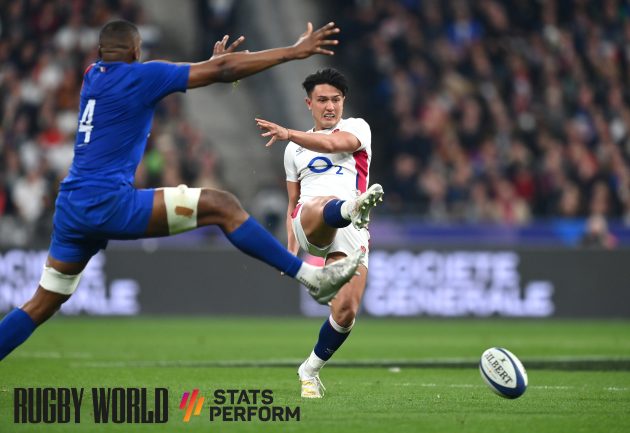With the help of Opta by Stats Perform, we look at some of the kicking styles used during the Six Nations
Six Nations analysis: Kicking styles
Kicking. We’re obsessed with it. It’s evil; it’s the future; it’s a tool; it’s a whole identity. The way we talk about it can be so muddling.
So we decided just to look back on the Six Nations with the help of Opta by Stats Perform, just to get more of a handle on kicking styles through the tournament. With particular focus on what teams did as they headed into opposition territory.
As we pointed out in our piece on a tale of two playing styles from Ireland and France, only Italy kicked more than France during this year’s men’s competition and even then only overtook them in the final round. France still had the most metres for the whole tournament, with the champions regularly opting to kick long. Opta calculate that they booted the ball 5,424m all in, almost 900m further than Italy who kicked next longest.
This table below is an average, from all of France’s matches.
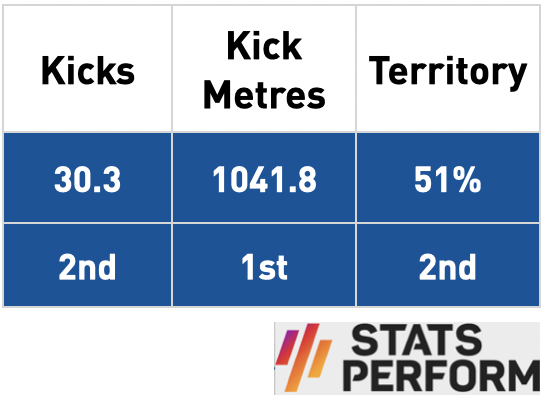
Ireland may have won the territory battle if you look at the tournament as a whole, and only purely at statistics. But it is clear France were content to let the opposition have the ball, on the field, and decide how they want to reply: Try to outmanoeuvre the French tacticians with a kick of their own, or run into that fierce defence. They also did not want to run around in their own half.
As France kick coach Vlok Cilliers told the Telegraph today: “(France) would play good rugby, but they would run when they were supposed to kick and kick when they were supposed to run. It was just important for us to find a balance. With that had to come more patience. That’s the one thing we’ve worked hard on.”
Kicks in this tournament grabbed attention for various reasons. Whether the Tadhg Beirne 50:22 that stunned fans or a Melvyn Jaminet version that set the platform for a score, or the Finn Russell pair to tee up a penalty try in the Calcutta Cup, they can prove sensational.
But if you think of the Six Nations sides now, and without going back to pore over the games, how much would you assume they kicked it – and where?
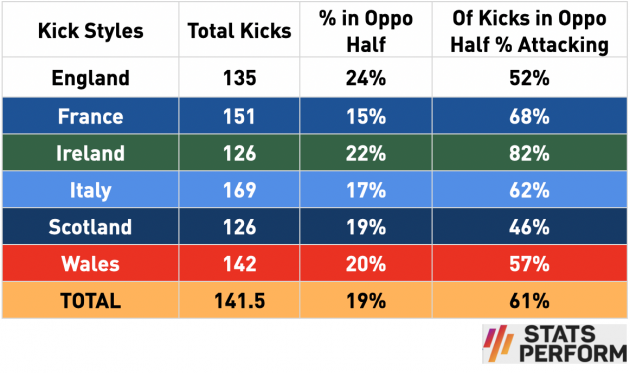
We mentioned the volume for Italy and France, but where teams operated is interesting.
For starters, England had the highest percentage of kicks in the opposition half, compared to rivals. Visions of Marcus Smith trying to create havoc in the French 22 come to mind here. But it is also worth nothing what percentage of kicks in the opposition half were ‘attacking’.
In the way Opta collect their data, attacking kicks are defined as chips, cross-field kicks, grubbers and bombs. Not included are territorial punts, kicks to touch or box kicks.
As analyst Ross Hamilton surmises: “France had the lowest percentage of their kicks in the opposition half but of those they did put in, they made the second-most attacking kicks. So low volume in total, but a high percentage of the kicks they did put in, in the opposition half, were ‘attacking’.
“Ireland had the joint fewest kicks overall but the most by miles of their kicks in the opposition half were attacking.”
While Italy made the most kicks, very few were in the opposition half, while Scotland made the joint-fewest overall and also put in the lowest percentage of attacking kicks from their total kicks in the opposition half. Which is something to bear in mind, considering the perception we have of a Finn Russell-led Scotland attack.
It also gets us thinking about personnel and the fly-halves who are so scrutinised for how they move their team around.
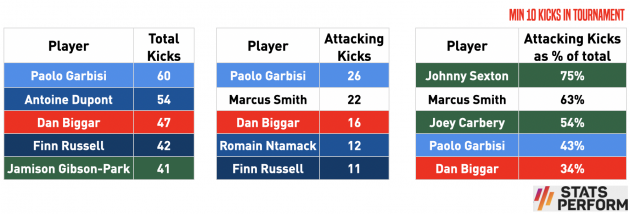
What leaps out at you is that 75% of all Johnny Sexton’s kicks in the tournament were classed as attacking kicks, according to Opta (again, see the explanation above). He is not in the two other columns because he only made 12 kicks in total, with nine of those attacking. It has the feel of a more selective approach.
If you look at the attacking percentage, though, you clock that Russell is also not in that top five. He is actually next on the list, with 30% of his kicks being tagged as attacking, which is from his 42 kicks overall as you can see.
Considering Scotland had the lowest number of kicks, and the fewest attacking kicks in the opposition 22, and considering Russell’s reputation as one of the trickiest attacking kickers in the game, perhaps you would expect more.
His 11 is obviously still more than Sexton’s nine. And of course, just because the volume is high for some kickers does not mean that every kick was quality. And whether it was a shot to nothing with penalty advantage isn’t included here.
What isn’t in here either is how each team approaches their style of game, and the nuances within that. It is another subject to consider how much go-forward these teams have, and if a kicker is on their heels because the team are making little headway with ball in hand.
However, it’s good to use these as a conversation starter.
Particularly if you then want to compare figures from the most recent Rugby Championship.
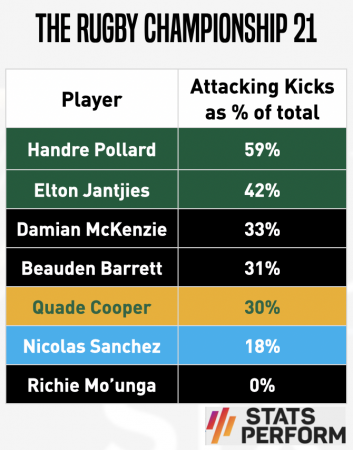
It’s worth being aware of a few details here. Firstly, we are looking at players who played at fly-half. Pollard made 20 attacking kicks across five games and 385 minutes of action. Richie Mo’unga had 78 minutes in the position, according to Opta.
As you can see, Pollard streaks ahead. If you compare him to this year’s Six Nations pilots, he would have been third on the list for most attacking kicks.
Kicking for territory and tactics is vital in today’s game. But so too is having the option of attacking kicks. What you have to ask, looking at the above, is: Who got the balance right, and who went too often or not enough?
Download the digital edition of Rugby World straight to your tablet or subscribe to the print edition to get the magazine delivered to your door.
Follow Rugby World on Facebook, Instagram and Twitter.





